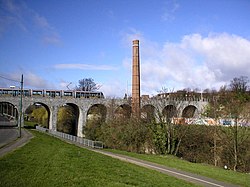Milltown, Dublin
Milltown
Baile an Mhuilinn | |
|---|---|
Suburb | |
 TheNine Arches Viaductover theRiver Dodder | |
| Coordinates:53°18′40″N6°14′53″W/ 53.311°N 6.248°W | |
| Country | Ireland |
| Province | Leinster |
| County | Dublin |
| Population (2011) | |
| •Urban | 1,973[1] |
| Irish grid reference | O168302 |
Milltown(Irish:Baile an Mhuilinn)[2]is a suburb andtownlandon thesouthsideofDublin,Ireland.Milltown was the site of several working mills on theRiver Dodderand is also the location of the meeting of theRiver Slangwith the Dodder. It is located adjacent to other suburban areas such asWindy Arbour,Ranelagh,Rathmines,Dartry,Clonskeagh,andDonnybrook.
History[edit]
The townland of Milltown, also known as Milton,[3]was so named from at least the 14th century.[4]Both Milltown andClonskeaghwerelibertiesof Dublin following the 13th-centuryAnglo-Norman invasion of Ireland.[citation needed]
In his 1903 work,A History of the County Dublin,the historianFrancis Elrington Balldescribes Milltown as being the "scene of industrial enterprise" from a "very early period" and that as "early as the fourteenth century the existence of a mill is mentioned".[3]Ball also states that "mediaeval quarrying operations carried on at Milltown" provided stone for repairs to Dublin'sChrist Church Cathedral.[3]
By the 18th century, the area was home to several mills - including two corn mills, an iron mill and paper mill.[3]A formermill racewas taken from just above theweirlocated 100m downstream from theNine Arches Viaduct.It ran towards a mill which was located in what is nowDodder Park.The remnants of this mill can still be seen.[5]

Historically used as afording pointon the River Dodder,[3]a bridge was built at Milltown in the 17th century.[6]This bridge, known as "(Old) Milltown Bridge" or "Packhorse Bridge", is recorded in theRecord of Monuments and Placesand classified as aprotected structure.[7][8][9]A newer bridge was later built at Milltown,[9]and by the early 20th century the older structure was used only for pedestrian traffic.[3]The newer Milltown Bridge was built on the site of the former ford, which was in use up until at least the late 18th century.[3]
Transport[edit]
Milltown is marked by a landmark 19th-century railway bridge across the river, which was part of theHarcourt Street railway linewhich ran fromHarcourt StreettoBray.This bridge, and sometimes the area immediately surrounding it, became known as the 'Nine Arches'.Milltown railway stationopened on 1 May 1860 and finally closed on 31 December 1958.[10] On 30 June 2004, the bridge was re-opened for theLuaslight rail system which runs fromBroombridgetoBride's Glen.There is also a Luas stop a few yards north of the former station.
Milltown is also served byDublin Busroute 44 which runs fromDublin City University(DCU) toEnniskerry.[11]
Sport[edit]
The area is still associated withShamrock Roversfootball club, who played there atGlenmalure Parkon land leased from theJesuits,from 1926 until 1987 when it was controversially sold to developers.[12][13] Milltown Golf Club celebrated its centenary in 2007.[14]
Administrative area[edit]
Milltown is located along the River Dodder, which in this area, marks the boundary between the two council areas ofDublin City CouncilandDún Laoghaire–Rathdown County Council.Milltown lies in both, with the village falling within Dublin City.[15]
Education[edit]
Alexandra College,aChurch of Irelandgirls' school,is located in Milltown, as is theAhlul Bayt Islamic Centre,the onlyShiamosquein Ireland.[5]
TheJesuitshave a long presence at Milltown with a secondary school for boys,Gonzaga Collegeon its lands at Milltown Park. The Jesuit Training College evolved into theMilltown Institute of Theology and Philosophya recognised college of theNational University of Ireland.TheNational College of Industrial Relationswas also founded by Jesuits on its lands in Milltown, which eventually moved to theIFSCbecoming theNational College of Ireland.
The Franciscan Brothers of theThird Order Regular,noted for their having secretly taught the boys of the Catholic population for decades in underground schools, had formed a monastery and school here, after the relaxation of thePenal Lawswhich had forbidden Catholic education. In 1818 they transferred their monastery toMountbellewinCounty Galway.[16]
Mount St. Mary's was formerly the seminary of theMarist Fathers,[17]students for the priesthood would study theology with the Jesuits in Milltown Park, and also study for degrees in Arts or Science in UCD, while based in Mount St. Marys.
See also[edit]
- List of towns and villages in Ireland
- Old Moore's Almanac,an almanac which has been published since 1764 by Theophilus Moore, who ran a classical academy at Milltown
References[edit]
- ^"Census 2011 - Preliminary results".Archived fromthe originalon 29 October 2013.Retrieved16 August2012.
- ^"Baile an Mhuilinn / Milltown".logainm.ie.Placenames Database of Ireland.Retrieved21 June2024.
- ^abcdefgBall, F. Elrington(1903).A History of the County Dublin, Volume 2(PDF).Dublin: Alex. Thom & Company. pp. 110–113.
- ^D'Alton, John(1838).The History of the County of Dublin.Dublin. p. 685.
In 1353 the king committed to William de Barton [..] the custody of one mill, one carucate, and fifty acres of land in Saggard, Milltown [..] and Kilmactalway
- ^ab"Milltown, Dublin, Rate My Town".Archived fromthe originalon 18 August 2012.Retrieved16 August2012.[better source needed]
- ^"Dodder Park at Milltown".sportsworldrunningclub.Retrieved21 June2024.
- ^"Dublin City Development Plan 2022-2028 - Volume 4 - Record of Protected Structures"(PDF).Dublin City Council.Retrieved21 June2024.
RPS Ref. No. [..] 892 [..] Bridges: River Dodder, Dublin 6 [..] Packhorse Bridge, Milltown Road
- ^"Record of Monuments and Places - DLR / Fingal / South Dublin / Dublin Borough"(PDF).National Monuments and Historic Properties Service. 1998.Retrieved21 June2024– via archaeology.ie.
DU022-00401- [..] 3329 [..] Milltown Bridge (Old)
- ^abSimington, T; O'Keeffe, P (1991).Irish stone bridges: history and heritage.Dublin: Irish Academic Press.ISBN9781911024149.
- ^"Milltown station"(PDF).Railscot - Irish Railways.Archived(PDF)from the original on 26 September 2007.Retrieved4 November2007.
- ^"Milltown".Luas.
- ^"25 years on: Shamrock Rovers' last match in Milltown revisited".12 April 2012.Archivedfrom the original on 18 September 2012.Retrieved15 August2012.
- ^"Shamrock Rovers".Archived fromthe originalon 3 April 2012.Retrieved15 August2012.
- ^"Milltown Golf Club - Home".Archivedfrom the original on 26 April 2019.Retrieved15 August2012.
- ^"Milltown Car Park Bottle Bank".Dublin City Council.10 August 2020.Archivedfrom the original on 27 April 2021.Retrieved27 April2021.
- ^"Our History".Franciscan Brothers of Brooklyn.Archivedfrom the original on 5 January 2013.Retrieved11 January2013.
- ^Marist Fathers Ireland.Archived2010-03-04 at theWayback Machine

